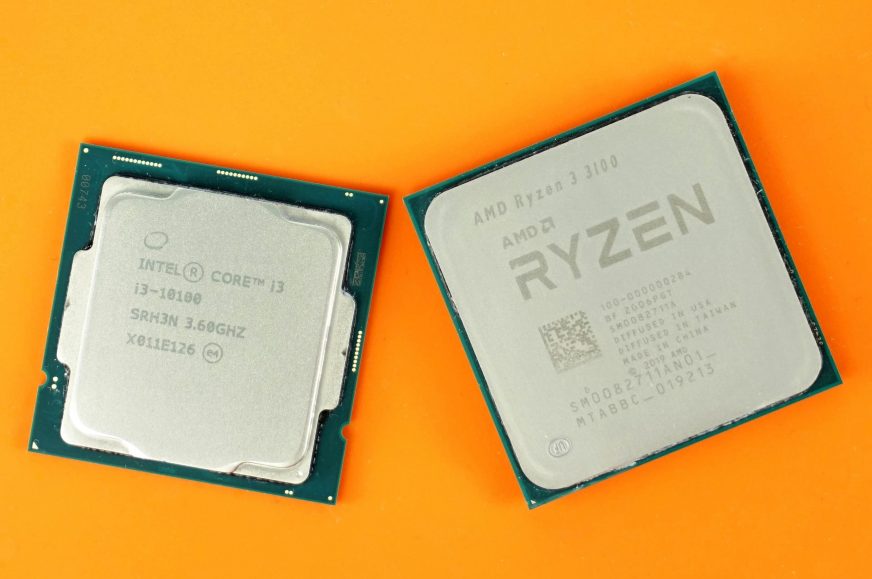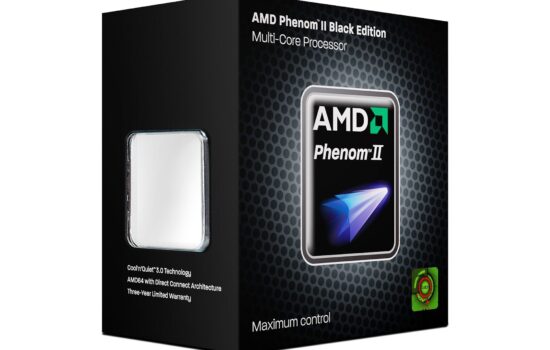Intro
A year has passed since the introduction of AMD’s Ryzen third generation, but the product line was still not complete. We were waiting for the lowest line to be refreshed with the designation Ryzen 3. In the meantime, the 10th generation of Intel Core processors has been released, including new i3 SKUs. We got novelties from both manufacturers, namely Ryzen 3 3100 and Core i3-10100. Which one is better?
Basic specs
| Parameters | AMD Ryzen 3 3100 | Intel Core i3-10100 | |
| Processor cores | |||
| Processor cores | 4 | 4 | |
| Processor threads | 8 | 8 | |
| Base frequency | 3600 MHz | 3600 MHz | |
| Precision/Turbo Boost frequency | 3900 MHz | 4300 MHz | |
| Supported RAM freqency | 3200 MHz | 2666 MHz | |
| Memory channles | 2 | 2 | |
| Intedrated graphics adapter | no | yes, UHD 630 | |
| L1 Cache | 256 KiB | 256 KiB | |
| L2 Cache | 2 MiB | 1 MiB | |
| L3 Cache | 16 MiB | 6 MiB | |
| TDP | 65 W | 95 W | |
| Cooler | AMD Wraith Stealth | yes | |
| Lithography | 7 nm FinFET (TSMC) | 14 nm | |
| Version of PCI Express (and lines) | 4.0 (16 + 4) | 3.0 (16) | |
| Socket | AMD AM4 (PGA 1331) | Intel FCLGA1200 | |
| Overclocking | yes | no | |
| Price incl. VAT (czc.cz) | 2990 CZK/110 EUR | 3561 CZK/130 EUR |
The third Ryzen 3 generation brings several changes. For the first time in this product line, we see Hyperthreading (or in AMD’s terminology it is SMT – Simultaneous Multi-Threading), i.e. two threads per core. So far, all of these processors have had 4 cores and 4 threads. 4 cores remained, but they already have 8 threads. This was until recently the configuration you could find in Core i7-7700K. Now it is in entry level processors. Compared to the previous first and second Ryzen 3 generations, the processors received higher base clock speed and a boost. More precisely, in the case of the 3100, it is 3.6 GHz base clock and 3.9 GHz boost clock. It is still true that the processors are unlocked for overclocking. The cache has been increased to a total of 18 MB. The 65 W TDP has also been retained. Support for PCIe 4.0, which we already know from Ryzen 5, 7 and 9, has been added. We know about the 7 nm Zen 2 architecture that it brings significant IPC improvements and is also more energy efficient, although power draw should not be a problem in this class of processors at all. Along with new Ryzen 3 processors, cheaper motherboards with B550 chipset are also coming to the market. We already have several units on the way, but a X570 mobo was used to test the processor.
On the other side of the ring, we have the 10th generation of Intel Core processors codenamed Comet Lake. It comes in difficult times for Intel which is attacked by AMD on probably all fronts. Perhaps the biggest problem is that we are still looking at 14 nm processors, which after the number 14 already carry so many ‘+’ symbols, it is no longer entertaining. It’s basically the fifth iteration of Skylake which doesn’t bode well. Concerns about the Core i9-10900K overheating are spreading like crazy which is not surprising. We will also test new Core i7 and i9 SKUs, but back to the topic. The i3-10100 also brings Hyperthreading to the four cores. Until now, Ci3-9100 and Ci3-8100 have been quad-core/four-thread and Ci3-7100 and Ci3-6100 have even been only dual-core with HT. It’s interesting where have we moved in just 3 years, right? (When the Core i3 has gear like a former i7 …).
Of course, the Ci3-10100 has lower clock speed than the mentioned Ci7-7700K, but it’s the principle. Apart from HT, not many changes have taken place, the base clock is still 3.6 GHz as well as those of 9100 and 8100. The boost has increased slightly to 4.3 GHz, but this is true for two cores, the all-core boost is 4.1 GHz. The processor got support for 2666 MHz RAM up to 128 GB. The integrated graphics is still UHD Graphics 630, no major changes have taken place here. But the change that definitely does not feel good is the transition to LGA 1200 socket which is already a classic way of Intel to force users to buy new motherboards after two years. This time, this is justified by the fact that LGA 1200 will already be compatible with Rocket Lake processors from the upcoming 11th generation which are already supposed to support PCIe 4.0, which has been present in Ryzen for a year. However, I can imagine that in two years’ time we will have a new socket here again so that the 10th generation does not slow down progress. In the red team, however, we see how it should work properly and AM4 will support the 4th generation of processors.
Testing methodology
We tested the processors at home, not in a laboratory environment. Nevertheless, the effort was made for the most accurate results. These are therefore the average of the measured values from repeated tests. We tried to eliminate factors that would affect performance in addition to the processor itself and the motherboard. We used the same components in both cases. The idea of all tests was to use base settings and turning on XMP, no other adjustments were made. This is how most users will actually function.
| Test setup | ||
| Processor | AMD Ryzen 3 3100 | Intel Core i3-10100 |
| Motherboard | Gigabyte X570 Aorus Xtreme | Gigabyte Z490-I Aorus Ultra |
| CPU cooler | Fractal Design Celsius S36 | Fractal Design Celsius S36 |
| Thermal compound | Noctua NT-H1 | Noctua NT-H1 |
| RAM | Corsair Dominator Platinum RGB, 2× 8 GB, 3600 MHz/CL16 | |
| Graphics card | Gigabyte Aorus RTX 2080 Ti Xtreme OC 11 G | Gigabyte Aorus RTX 2080 Ti Xtreme OC 11 G |
| SSD | Gigabyte Aorus PCIe 4.0 NVMe SSD 2 TB | Adata XPG Gammix S11 Pro 1 TB |
| Power supply | SeaSonic Prime 1300 W (80Plus Gold) | SeaSonic Prime 1300 W (80Plus Gold) |
| PC case | Lian Li PC-T70 |
- Contents
- Intro
- Rendering and Geekbench
- Gaming, graphics tests and PC/3DMark
- Encryption, encoding and memory tests
- Heating and power draw
- Rating












nice post and AMD Ryzen 3 vs Intel i3 – Detailed Comparison
full details click here http://www.betateck.com/amd-ryzen-3-vs-intel-i3-detailed-comparison/